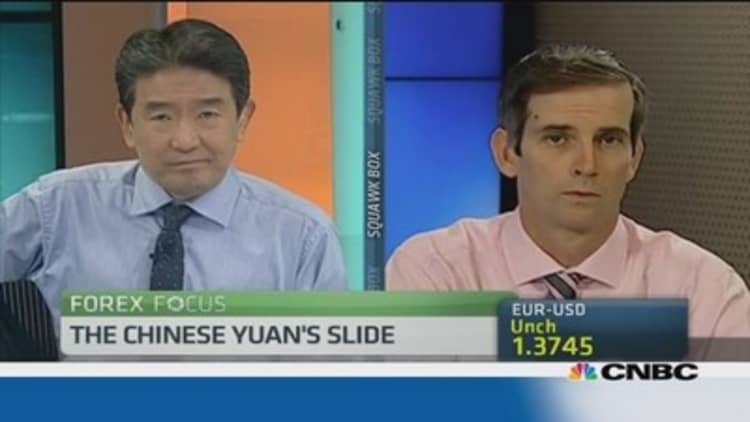
This week's slide in the Chinese yuan to a seven-month low versus the dollar could be a precursor to the next big change in Beijing's currency policy – a widening of the yuan's trading band.
The yuan weakened below its official fixing for a second straight day on Wednesday after falling below its mid-point on Tuesday for the first time since September 2012.
(Read more: Does the yuan's slide mark a major shift in policy?)
There is talk that China's central bank has been intervening in the market to increase volatility ahead of possible reforms, which could include a widening of the yuan's trading band as a step towards liberalizing the Chinese currency.
"We believe the PBOC [People's Bank of China] is paving the way for band widening, which is likely to occur in the coming weeks to plus or minus two percent," analysts at ANZ Bank said in a note. "But this is not a deliberate shift in FX policy towards a weaker yuan."
The yuan is currently allowed to rise or fall by 1 percent in either direction from a level fixed against the dollar each day by the country's central bank. The band was last widened in 2012, to 1 percent from 0.5 percent and analysts say the band is likely to be widened to 2 percent on either side of the daily fixing.
The 's mid-point was set at 6.1192 per dollar on Wednesday and the currency weakened to 6.1351 – its lowest level since last July.
(Read more: China's $12 trillion corporate debt pushes up refunding costs)
"What we've seen in the past few days is a pretty sharp short-squeeze in dollar/yuan that was one of the few remaining consensus trades left in the market," said Callum Henderson, global head of currency research at Standard Chartered Bank.
"What we don't expect is a change in policy in terms of yuan appreciation but we do see the PBOC as delivering on its commitment of greater two–way volatility ahead of a band widening," he said, adding that he expected band widening in the second or third quarter.
Six-month chart of dollar/yuan
Analysts added that infusing greater volatility into yuan trade could also be taken as sign of Beijing allowing "market forces" to drive the currency market.
"The third plenary of the People's Congress last year used market forces many times in their statement. We've seen some vicious squeezes in money market rates over the past year and this (the move in the yuan) could be another example of market forces at work," Robert Rennie, global head of currency strategy at Westpac Bank, told CNBC Asia's "Squawk Box."
(Read more: Does China plan to use gold to internationalize the yuan?)
Analysts said they were keeping their forecasts for the yuan to end the year higher against the greenback unchanged for now.
RBS Chief China Economist told CNBC he expected "fundamental drivers" to push the yuan to 5.88 per dollar by year-end. Standard Chartered's Henderson maintained a target for the yuan to hit 5.92 by the end of the year, while Morgan Stanley said it was keeping its dollar/yuan forecast at 5.91 – implying a gain of about 3.5 percent by year-end.
— Writing by CNBC's Dhara Ranasinghe. Follow her on Twitter at @DharaCNBC


